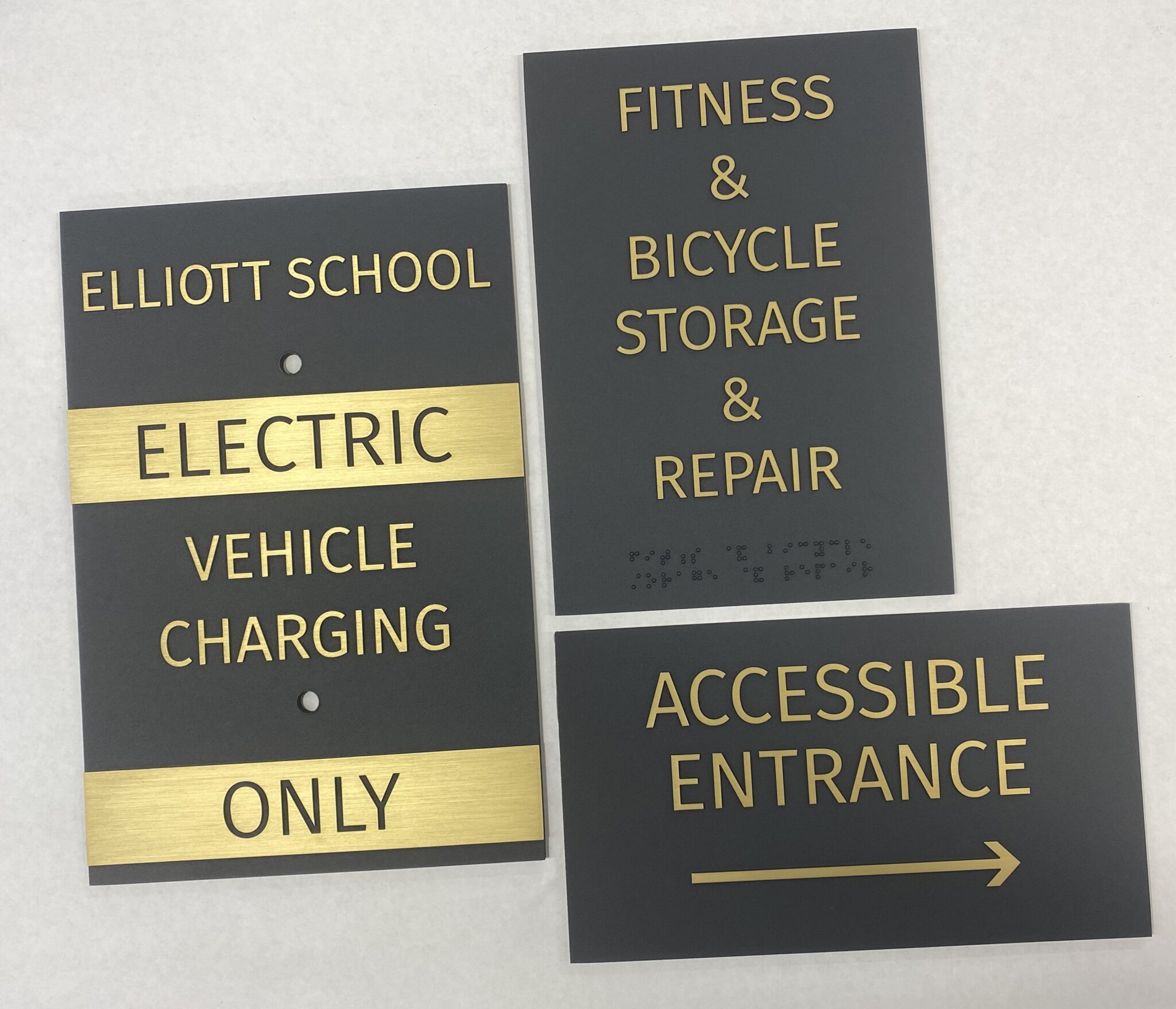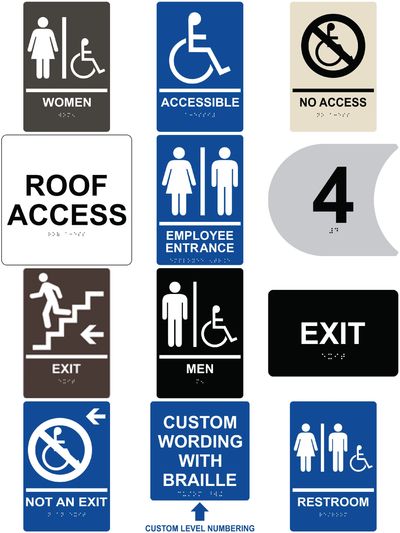ADA Signs: Crucial Devices for Inclusive Environments
ADA Signs: Crucial Devices for Inclusive Environments
Blog Article
Exploring the Trick Functions of ADA Signs for Improved Ease Of Access
In the realm of access, ADA indicators function as silent yet powerful allies, ensuring that spaces are accessible and inclusive for individuals with impairments. By integrating Braille and tactile aspects, these signs damage obstacles for the visually damaged, while high-contrast color design and readable typefaces satisfy varied aesthetic needs. Their strategic placement is not approximate however rather a computed effort to assist in smooth navigation. Past these features lies a deeper story about the development of inclusivity and the recurring commitment to developing fair rooms. What a lot more could these signs indicate in our quest of universal ease of access?
Relevance of ADA Conformity
Making sure conformity with the Americans with Disabilities Act (ADA) is vital for promoting inclusivity and equivalent gain access to in public areas and work environments. The ADA, established in 1990, mandates that all public facilities, employers, and transport services suit people with disabilities, guaranteeing they appreciate the exact same legal rights and opportunities as others. Compliance with ADA standards not only meets lawful responsibilities but additionally boosts a company's credibility by showing its commitment to diversity and inclusivity.
One of the vital aspects of ADA compliance is the execution of easily accessible signage. ADA indications are designed to ensure that individuals with impairments can easily browse with structures and areas.
In addition, sticking to ADA guidelines can mitigate the threat of possible fines and legal consequences. Organizations that fail to follow ADA guidelines may face lawsuits or charges, which can be both monetarily difficult and damaging to their public picture. Thus, ADA compliance is integral to fostering an equitable setting for everyone.
Braille and Tactile Components
The unification of Braille and tactile components right into ADA signs personifies the concepts of access and inclusivity. These functions are vital for individuals that are blind or aesthetically impaired, allowing them to navigate public areas with better independence and confidence. Braille, a responsive writing system, is vital in supplying composed information in a style that can be conveniently regarded via touch. It is commonly positioned beneath the corresponding message on signs to make certain that people can access the details without aesthetic help.
Responsive elements extend beyond Braille and consist of increased characters and icons. These components are created to be noticeable by touch, enabling individuals to determine room numbers, toilets, exits, and various other critical locations. The ADA sets specific standards regarding the size, spacing, and placement of these responsive elements to enhance readability and guarantee consistency across different settings.

High-Contrast Color Pattern
High-contrast color design play an essential duty in boosting the presence and readability of ADA signs for people with aesthetic impairments. These plans are essential as they maximize the distinction in light reflectance in between message and background, guaranteeing that indications are quickly noticeable, even from a distance. The Americans with Disabilities Act (ADA) mandates making use of particular color contrasts to suit those with minimal vision, making it an essential aspect of compliance.
The efficiency of high-contrast colors here hinges on their dig this capability to attract attention in different lights conditions, consisting of dimly lit atmospheres and areas with glow. Generally, dark text on a light history or light message on a dark history is utilized to accomplish ideal comparison. Black text on a yellow or white background gives a raw aesthetic difference that assists in fast recognition and comprehension.

Legible Fonts and Text Dimension
When taking into consideration the design of ADA signs, the selection of understandable fonts and suitable message size can not be overemphasized. These components are vital for making sure that indications come to individuals with aesthetic impairments. The Americans with Disabilities Act (ADA) mandates that typefaces have to be not italic and sans-serif, oblique, manuscript, very decorative, or of uncommon type. These demands assist ensure that the message is conveniently legible from a distance which the personalities are appreciable to diverse audiences.
The dimension of the text additionally plays an essential role in ease of access. According to ADA guidelines, the minimal text height should be 5/8 inch, and it needs to raise proportionally with seeing distance. This is particularly important in public rooms where signage demands to be read quickly and properly. Uniformity in message Homepage size adds to a natural visual experience, assisting individuals in navigating settings effectively.
Moreover, spacing in between lines and letters is indispensable to legibility. Appropriate spacing prevents characters from appearing crowded, boosting readability. By adhering to these criteria, developers can considerably improve ease of access, making certain that signs serves its designated purpose for all individuals, no matter of their visual abilities.
Reliable Positioning Strategies
Strategic positioning of ADA signage is vital for making best use of availability and guaranteeing compliance with legal criteria. Effectively located indications direct people with handicaps effectively, facilitating navigating in public areas. Key considerations include presence, closeness, and elevation. ADA guidelines state that indicators need to be placed at an elevation between 48 to 60 inches from the ground to ensure they are within the line of sight for both standing and seated individuals. This basic height variety is vital for inclusivity, making it possible for mobility device customers and people of differing elevations to accessibility details easily.
In addition, indicators need to be positioned nearby to the latch side of doors to permit very easy identification before access. Uniformity in indication positioning throughout a facility improves predictability, lowering complication and improving general customer experience.

Final Thought
ADA indications play a vital function in advertising ease of access by integrating features that attend to the needs of people with impairments. These aspects collectively foster a comprehensive environment, underscoring the importance of ADA conformity in guaranteeing equivalent accessibility for all.
In the world of access, ADA indicators offer as silent yet effective allies, making certain that spaces are comprehensive and navigable for people with impairments. The ADA, passed in 1990, mandates that all public facilities, employers, and transport services suit individuals with handicaps, guaranteeing they enjoy the very same civil liberties and opportunities as others. ADA Signs. ADA signs are created to make certain that people with handicaps can easily navigate through rooms and structures. ADA guidelines specify that indications need to be mounted at an elevation between 48 to 60 inches from the ground to guarantee they are within the line of view for both standing and seated individuals.ADA indicators play a vital duty in advertising availability by incorporating attributes that resolve the demands of people with specials needs
Report this page